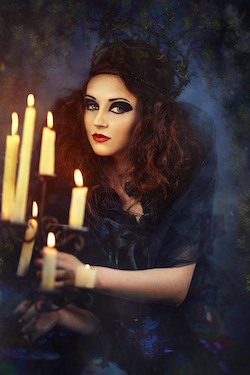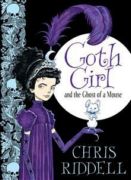By T. Gail Pritchard, Ph.D., University of Arizona
 This week’s blog focuses on the 2013 Costa Children’s Book Award winner, Goth Girl and the Ghost of a Mouse, written and illustrated by the U.K.’s Children’s Laureate Chris Riddell. The Costa Book Awards honor authors in the U.K. and Ireland in five categories: First Novel, Novel, Biography, Poetry, and Children’s Book. One unique aspect of the Costa is that it “places children’s books alongside adult books.” The 2015 Children’s Book Award winner, The Lie Tree by Frances Hardinge (reviewed by Melissa in this month’s blog) was also the 2015 Costa Book of the Year.
This week’s blog focuses on the 2013 Costa Children’s Book Award winner, Goth Girl and the Ghost of a Mouse, written and illustrated by the U.K.’s Children’s Laureate Chris Riddell. The Costa Book Awards honor authors in the U.K. and Ireland in five categories: First Novel, Novel, Biography, Poetry, and Children’s Book. One unique aspect of the Costa is that it “places children’s books alongside adult books.” The 2015 Children’s Book Award winner, The Lie Tree by Frances Hardinge (reviewed by Melissa in this month’s blog) was also the 2015 Costa Book of the Year.
Most of you are probably familiar with Riddell’s works, in particular The Edge Chronicles, co-created with Paul Stewart, so you know he is a wordsmith extraordinaire and a gifted artist. He does not disappoint with Goth Girl.
 Ada Goth, based on Lord Byron’s daughter Ada Lovelace, is the hero of the series. In this initial volume, we meet Ada as a young girl who lives in a huge, gloomy manor with her father, the servants, and her governess du jour. There is wailing at night — ghosts, monsters, a vampire (the new governess), mythological creatures, and literary beings roaming the grounds. In short, it is classic goth. What makes this particularly fun goth, is the humor Riddell injects throughout. For example, one of the guests for Lord Goth’s annual party is novelist Mary Shellfish, author of The Monster, or Prometheus Misbehaves; another guest is the bad guy, von Hellsung who carries the twin-quadruple-barrelled pistols, Hansel and Gretel; and then there is The Secret Garden and The Even More Secret Garden. Ada and her new friends, along with the Ghost Mouse — who introduces himself by saying, “Call me Ishmael,” are under the gun (so to speak) to foil the “indoor” gamekeeper’s dastardly plan to harm some of the invited guests and along the way, we find out just a bit about Ada and her friends’ lives at Ghastly-Gorm Hall.
Ada Goth, based on Lord Byron’s daughter Ada Lovelace, is the hero of the series. In this initial volume, we meet Ada as a young girl who lives in a huge, gloomy manor with her father, the servants, and her governess du jour. There is wailing at night — ghosts, monsters, a vampire (the new governess), mythological creatures, and literary beings roaming the grounds. In short, it is classic goth. What makes this particularly fun goth, is the humor Riddell injects throughout. For example, one of the guests for Lord Goth’s annual party is novelist Mary Shellfish, author of The Monster, or Prometheus Misbehaves; another guest is the bad guy, von Hellsung who carries the twin-quadruple-barrelled pistols, Hansel and Gretel; and then there is The Secret Garden and The Even More Secret Garden. Ada and her new friends, along with the Ghost Mouse — who introduces himself by saying, “Call me Ishmael,” are under the gun (so to speak) to foil the “indoor” gamekeeper’s dastardly plan to harm some of the invited guests and along the way, we find out just a bit about Ada and her friends’ lives at Ghastly-Gorm Hall.
Pepetone (2012) notes that in gothic children’s literature, one type of protagonist is “exposed to a series of trials and traumas that must be dealt with either positively…with critical introspection…or else negatively…with denial…and self-destruction” (p. 221). Ada faces her trials with dignity, courage, and humor.
Lord Goth, desperately grieving his beloved wife’s tight-rope walking death, only sees Lady Goth when he looks at Ada. He “never talked about that terrible night. Instead he stayed at home in his huge house, shut away in his study writing extremely long poems . . . Since the accident, Lord Goth had taken to believing that children should be heard and not seen” (Riddell, 2013, p. 9). Thus, Ada is forced to wear heavy, clunky, boots so Lord Goth can hear her coming and avoid her. Ada eventually, decides to trade in her boots for her mother’s black leather pumps (really her mother’s tightrope-walking slippers) and in the process, begins to establish her autonomy and identity, but not without conflict when she runs into her father and he is visibly disappointed that he did not hear her coming.
Ada, much like characters in other similar novels such as A Series of Unfortunate Events by Lemony Snicket, Ophelia and the Marvelous Boy by Karen Foxlee, and a classic — The Secret Garden by Frances Hodgson Burnett, “teaches us things are not always what they seem” (Howarth, 2014, p. 6). Ada’s life is tough — she has experienced the physical loss of her mother and the emotional loss of her father, but she finds a way, “instead to survive and prevail” (p. 7). Her relationship with her father is broken, yet she manages to put it back together while helping others along the way. And what makes this such an amazing read, is the way Riddell uses characters, wordplay, and detailed drawings to take the reader along on Ada’s journey.
Right away, we meet Ishmael, a shimmering ghost of a mouse, who can’t remember what happened to him; Mrs. Beat’em, the cook who serves up concoctions like rhinoceros-foot jelly and baked sea-otter pie; her many governesses, including the first, Morag Macbee who had a single tooth and large wart to her latest, Miss Borgia — a vampire. The backdrop is the upcoming annual “Indoor Hunt.” Guests from all over come to the hall to participate in a hobby horse race, a lavish meal, and a hunt inside the hall where the caught animals are turned loose; but there is something decidedly different about this year’s event.
Ada with her new friends — Emily and William (Emily paints watercolors and William is afflicted with the disease of blending in to whatever he is next to), and Ishmael explore the hall trying to uncover the circumstances leading to Ishmael’s ghostness. In the process, they discover some “hidden” guests and uncover the indoor groundskeeper plans for this year’s hunt. As Ada and her friends work furiously to unravel the evil plan and to stop the sinister von Hellsung, Riddell invites the reader into a story of loss, healing, and survival and introduces us to a delightful gothic series.
Goth Girl Series
Goth Girl and the Fete Worse than Death (2014)
Goth Girl and the Pirate Queen (2015)
Goth Girl and the Wuthering Fright (2015)
References
Howarth, M. (2014). Under the Bed, Creeping: Psychoanalyzing the Gothic in Children’s Literature. Jefferson, NC: McFarland& Company, Inc.
Pepetone, G. (2012). Hogwarts and All: Gothic Perspectives on Children’s Literature. Bern, Switzerland: Peter Lang Publishing.
Riddell, C. (2013). Goth Girl and the Ghost of a Mouse. NY, NY: Macmillan Children’s Books. 224 pp. ISBN: 0230759807.
Journey through Worlds of Words during our open reading hours: Monday through Friday 9 a.m. to 5 p.m., Saturday 9 a.m. to 1 p.m. Check out our two online journals, WOW Review and WOW Stories, and keep up with WOW’s news and events.
- Themes: Goth Girl and the Ghost of a Mouse, T. Gail Pritchard
- Descriptors: Awards, Books & Resources, Student Connections, WOW Currents
